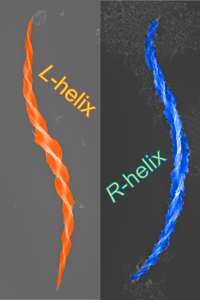Making twisted semiconductors for 3-D projection

A smartphone display that can produce 3-D images will need to be able to twist the light it emits. Now, researchers at the University of Michigan and the Ben-Gurion University of the Negev have discovered a way to mass-produce spiral semiconductors that can do just that.
Back in 1962, University of Michigan engineers E. Leith and J. Upatnieks unveiled realistic 3-D images with the invention of practical holography. The first holographic images of bird on a train were made by creating standing waves of light with bright and dark spots in space, which creates an illusion of material object. It was made possible by controlling polarization and phase of light, i.e. the direction and the timing of electromagnetic wave fluctuations.
The semiconductor helices created by U-M-led team can do exactly that with photons that pass through, reflected from, and emitted by them. They can be incorporated into other semiconductor devices to vary the polarization, phase, and color of light emitted by the different pixels, each of them made from the precisely designed semiconductor helices.
Until now, making semiconductors spirals with sufficiently strong twist – reminiscent of nanoscale fusilli pasta – was a difficult prospect because the twisted state is unnatural to semiconductor materials. They usually form sheets or wires. But Nicholas Kotov, Joseph B. and Florence V. Cejka Professor of Chemical Engineering and his team have found a way to guide the attachment of small semiconductor nanoparticles to each other learning from nature's twisted structures: proteins and DNA.
"Amino acids are the quintessential building blocks of proteins," said Wenchun Feng, a post-doctoral research fellow in Kotov's lab and the lead author. "The direction of the spiral of proteins is determined by the geometrical property of amino acids. We found that a common amino acid, cysteine, working together in large numbers can twist not only proteins but also semiconductors."
The team coated nanoparticles made out of cadmium telluride, a semiconductor capable of emitting light, with cysteine. Cysteine molecules come in two forms that are mirror images of one another, so it is known as a "chiral" molecule. They observed the nanoparticles spontaneously self-assembling into semiconductor "tornados" following the rightward or leftward chirality of the amino acid.
One of the unexpected findings of the team was how high the fidelity of this self-assembly process was and how strong the twist of the helices were. Nearly all – 98 percent – of semiconductor helices had the same twisting direction and indeed looked like nanoscale fusilli. Some organic molecules can form organic spirals, too, but the light-twisting ability of semiconductor helices made by Kotov and colleagues is at least five times stronger and can be varied by electrical field.
When they shone light through the semiconductors, they recorded the photons swirling through them. Through a combination of experiments and computer simulations, the researchers developed design principles and methods for engineering the optical properties of the semiconductor helices for the different colors in future holography devices.
One of the unexpected consequences of this technology-driven project was getting a peek into mysteries surrounding how life may have arisen on Earth and why many biological molecules reliably follow either a clockwise or counterclockwise spiral. Kotov suggests that amino acids, which are known to form spontaneously in space dust, may have assembled nanoparticles into spirals that twisted the light from the early stars, serving as stable inorganic templates for organic molecules and particles to follow the same pattern.
The work is described in a paper in Science Advances titled, "Assembly of mesoscale helices with near-unity enantiomeric excess and light-matter interactions for chiral semiconductors." View the abstract at advances.sciencemag.org/content/3/3/e1601159 .
More information: Wenchun Feng et al. Assembly of mesoscale helices with near-unity enantiomeric excess and light-matter interactions for chiral semiconductors, Science Advances (2017). DOI: 10.1126/sciadv.1601159
Provided by University of Michigan



















